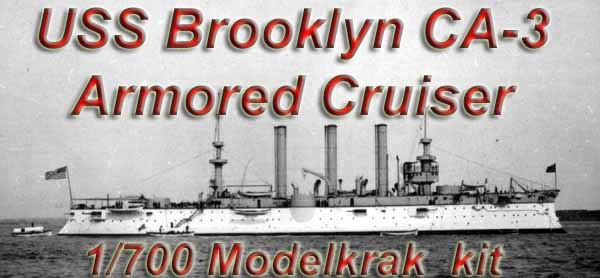
Reviewed by Timothy Dike

| The second BROOKLYN (CA-3) was launched 2 October 1895
by William Cramp and Sons Ship and Engine Building Co., Philadelphia, Pa.;
sponsored by Miss Ida May Schieren; and commissioned 1 December 1896, Captain
F. A. Cook in command.
BROOKLYN's first assignment was a special cruise to Great Britain with representatives of the United States for the Diamond Jubilee of Queen Victoria. The cruiser returned to the east coast in July 1897 and cruised there and in the West Indies until becoming flagship of the Flying Squadron under Commodore W. S. Schley, 28 March 1898. The Flying Squadron arrived at Cienfuegos, Cuba, 21 May 1898 and established the blockade of that port. On 26 May the Squadron arrived at Santiago, Cuba, where the Spanish Fleet was being held behind the protection of the forts. BROOKLYN was a key vessel in the Battle of Santiago (3 July 1898) in which the Spanish Fleet was destroyed. Although she was struck 20 times by whole shot, BROOKLYN suffered only one man wounded and one man killed. BROOKLYN returned to Tompkinsville, N. Y., 20 August 1898; cruised along
the Atlantic coast and in Caribbean waters; participated in the Spanish-American
War Victory Celebration at New York 5 October 1898; in the Dewey Celebration
at New York in September 1899. She left Hampton Roads, Va., 16 October
1899 and sailed via the Suez Canal to Manila, Philippine Islands, where
she arrived 16 December 1899. She became flagship of the Asiatic
Squadron and participated in the North China
On 20 May 1902 BROOKLYN was at Havana, Cuba for the ceremonies to transfer the authority on that Island from the United States Government to the Cuban Government. During June and July she was on special duty in connection with the obsequies of the late British Ambassador to the United States, Lord Pauncefote. During the next four years she cruised with the North Atlantic Fleet and the European Squadron, returning to New York 25 May 1905. On 1 June 1905, as flagship of Rear Admiral C. D. Sigsbee, she sailed for Cherbourg, France, where the remains of the late John Paul Jones were received aboard and brought to America. Upon arrival at Annapolis, Commodore Jones' remains were transferred ashore to a receiving vault at the Naval Academy with appropriate ceremonies 23 July 1905. On 16 May 1906, following a naval militia cruise (3-23 August 1905)
and a tour in the Mediterranean (28 December 1905-8 May 1906), BROOKLYN
went into reserve at League Island Navy Yard. Except for a short
period (30 June-2 August 1906) in commission for special service at Havana,
Cuba, she remained in reserve until the spring of 1907. During 12
April-4 December 1907 BROOKLYN served as part of the permanent display
at the Jamestown Exposition, Jamestown, Va. Following her return to
From: Dictionary of American Fighting Ships DANFS
CLASS - BROOKLYN
|
|
| The Hull is on this kit is pretty well cast though it does have a very large overpour at the waterline. The surface detail is pretty good, better than some earlier kits I have seen. The gun mounts in the hull are well formed and the overall level of detail is pretty good. |
to enlarge |
| Superstructure parts are few in number as this is nature
of the ship design. The bridge is pretty well cast but has a pretty thick
overpour like the hull.
The funnels are nicely done but the cutoff point for them is not redily apparent. The casting on the other small parts is well done as you can see by the photo's on the right. The vent piping is pretty well done and the majority of them were well formed. The gun barrels are pretty well cast for as small as they are. The boat davits are a little plain and I don't care so much for the way they are attached to the sprue. But since they are joined on a straight line they will be easy to remove. Ships boats are OK, but not as fine as some of the newer kits on the market. |
 |
 |
|
 |
|
| The instructions are a single sheet with a plan and elevation view and an exploded view. These are barely adequete to build this ship. You will need extra references to do it right. |  |
| Conclusions:
|
|